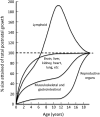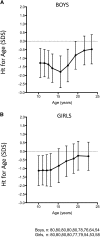Critical windows for nutritional interventions against stunting
- PMID: 23553163
- PMCID: PMC3628381
- DOI: 10.3945/ajcn.112.052332
Critical windows for nutritional interventions against stunting
Abstract
An analysis of early growth patterns in children from 54 resource-poor countries in Africa and Southeast Asia shows a rapid falloff in the height-for-age z score during the first 2 y of life and no recovery until ≥5 y of age. This finding has focused attention on the period -9 to 24 mo as a window of opportunity for interventions against stunting and has garnered considerable political backing for investment targeted at the first 1000 d. These important initiatives should not be undermined, but the objective of this study was to counteract the growing impression that interventions outside of this period cannot be effective. We illustrate our arguments using longitudinal data from the Consortium of Health Oriented Research in Transitioning collaboration (Brazil, Guatemala, India, Philippines, and South Africa) and our own cross-sectional and longitudinal growth data from rural Gambia. We show that substantial height catch-up occurs between 24 mo and midchildhood and again between midchildhood and adulthood, even in the absence of any interventions. Longitudinal growth data from rural Gambia also illustrate that an extended pubertal growth phase allows very considerable height recovery, especially in girls during adolescence. In light of the critical importance of maternal stature to her children's health, our arguments are a reminder of the importance of the more comprehensive UNICEF/Sub-Committee on Nutrition Through the Life-Cycle approach. In particular, we argue that adolescence represents an additional window of opportunity during which substantial life cycle and intergenerational effects can be accrued. The regulation of such growth is complex and may be affected by nutritional interventions imposed many years previously.
Figures






Comment in
-
Critical windows for nutritional interventions against stunting.Am J Clin Nutr. 2013 Sep;98(3):854-5. doi: 10.3945/ajcn.113.066647. Am J Clin Nutr. 2013. PMID: 23964056 No abstract available.
-
Reply to JL Leroy et al.Am J Clin Nutr. 2013 Sep;98(3):856-7. doi: 10.3945/ajcn.113.066704. Am J Clin Nutr. 2013. PMID: 24137695 No abstract available.
References
-
- Victora CG, de Onis M, Hallal PC, Blössner M, Shrimpton R. Worldwide timing of growth faltering: revisiting implications for interventions. Pediatrics 2010;125:e473–80. - PubMed
-
- Shrimpton R, Victora CG, de Onis M, Lima RC, Blössner M, Clugston G. Worldwide timing of growth faltering: implications for nutritional interventions. Pediatrics 2001;107:E75. - PubMed
-
- World Health Organisation. WHO child growth standards based on length/height, weight and age. Acta Paediatr Suppl 2006;450:76–85. - PubMed
-
- Darnton-Hill I, Nishida C, James WP. A life course approach to diet, nutrition and the prevention of chronic diseases. Public Health Nutr 2004;7:101–21. - PubMed
-
- ACC/SCN. Fourth report on the world nutrition situation: nutrition through the life cycle. Geneva, Switzerland: Administrative Committee on Coordination/Sub-Committee on Nutrition, 2000.
Publication types
MeSH terms
Grants and funding
LinkOut - more resources
Full Text Sources
Other Literature Sources
Medical

